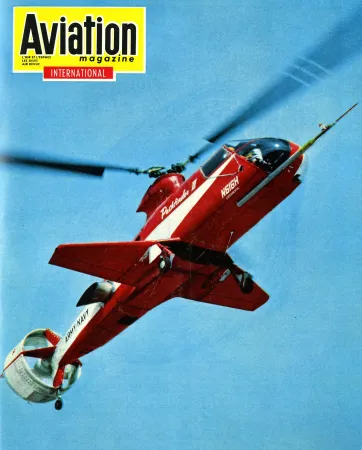A brief episode in the life of “Pi”, Part 1

You seem puzzled, my reading friend. Don’t tell me you have never seen this photo extracted from the 15 October 1967 issue of the French bimonthly Aviation magazine international. Given the circumstances, I have no choice but to provide you with some information.

A business derivative of the Piasecki Model 16 similar to the one whose production was considered for Picton, Ontario. David A. Brown, « Business Flying – New Helicopter Aimed at Business Market. » Aviation Week and Space Technology, 22 July 1968, 73.
Given the growing importance of the helicopter in Canada during the 1950s and 60s, both in civilian and military terms, it is not surprising that some foreign aircraft makers specialising in this type of production considered the possibility of setting up shop in Canada. While some projects were fairly well known, other have fallen into oblivion. In 1969, for example, Piasecki Aircraft Corporation signed an agreement with the Crown Assets Disposal Corporation for the purchase of buildings on Canadian Forces Base Picton, in Ontario, which closed in September. This small American aircraft maker relied on Piasecki Aircraft of Canada Limited to launch the production of a 15-seat compound business helicopter under development at the time. Piasecki Aircraft hoped to make two prototypes on Canadian soil and obtain their certification, all before mid-1972. In the end, this derivative of the Piasecki Model 16 Pathfinder did not proceed beyond the drafting table or model stage.
What is a compound helicopter, you ask, my reading friend? Let me tell you. It is a helicopter fitted with small wings and one or two propellers powered by one or two engines. A jet-powered compound helicopter is also possible of course. Let us now return to the main thread of our story.
The aforementioned compound business helicopter project owed its origins to a prototype internally funded by Piasecki Aircraft, the equally aforementioned Pathfinder, visible in the photo above. A prototype flew in February 1962. Its rear ducted propeller gave it a high speed. Impressed, the U.S. Army and U.S. Navy offered a development contract to Piasecki Aircraft in 1964, to demonstrate the effectiveness of the concept. The Pathfinder provided valuable data for the development of the Lockheed AH-56 Cheyenne compound attack helicopter, a high performance and promising two-seater tested in September 1967 but definitively abandoned in August 1972, for a variety of reasons (complexity, cost, size, vulnerability, etc.). Piasecki Aircraft proposed some civilian and military versions of the Pathfinder between 1968 and 1972. None of these found a customer.
The aircraft maker’s perseverance was rewarded in the first half of the 1990s, however, by the signing of research contracts supervised by the U.S. Army and U.S. Navy. These became a joint program in May 2004. A helicopter fitted with a vectored thrust ducted propeller by Piasecki Aircraft personnel flew in June 2007. Trials of this X-49 SpeedHawk seemingly ended around 2012-13.
The history of the Pathfinder and SpeedHawk is closely associated with a helicopter pioneer somewhat forgotten today, the American Frank Nicholas « Pi » Piasecki (1919-2008). His PV-2, designed and built by P-V Engineering Forum, flew in April 1943, for example. This organization, which became Piasecki Helicopter Corporation in 1946, developed the world’s first successful tandem rotor helicopter. This HRP Rescuer was the largest helicopter in the world when a prototype took to the sky in March 1945. The “flying banana,” as it was often called, is the ancestor of two search and rescue helicopters on display in Ottawa, Ontario, at the Canada Aviation and et Space Museum:
– the Piasecki HUP Retriever, and
– the Boeing Vertol CH-113 Labrador.
It should be noted that the Royal Canadian Navy apparently did not use the word Retriever to designate its HUPs. It should also be noted that the HUPs of the U.S Navy were sometimes called “Hupmobiles,” a term used by an American automobile manufacturer active until 1940 or so, Hupp Motor Car Company, to designate its vehicles.
A serious conflict within Piasecki Aircraft led to the departure of Piasecki and some colleagues. The company became Vertol Aircraft Corporation in March 1956. Piasecki founded Piasecki Aircraft in 1955. The company’s Canadian projects were by no means limited to the compound business helicopter. Please read the second part of this article to learn more.

More Stories by



















![A block of photographs showing some of the people involved in the bombing of beluga whales in the estuary and gulf of the St. Lawrence River. Anon., “La chasse aux marsouins [sic]. » Le Devoir, 15 August 1929, 6.](/sites/default/files/styles/thumbnail_7/public/2024-09/Le%20Devoir%2015%20aout%201929%20page%206.jpg?h=584f1d27&itok=TppdLItg)












































































































































































































![Peter Müller at the controls [sic] of the Pedroplan, Berlin, Germany, March 1931. Anon., “Cologne contre Marseille – Le mystère du ‘Pédroplan.’ [sic]” Les Ailes, 2 April 1931, 14.](/sites/default/files/styles/thumbnail_7/public/2021-04/Les%20Ailes%202%20avril%201931%20version%20big.jpg?h=eafd0ed4&itok=WnBZ5gMf)












![One of the first de Havilland Canada Chipmunk imported to the United Kingdom. Anon., “De Havilland [Canada] DHC-1 ‘Chipmunk.’” Aviation Magazine, 1 January 1951, cover.](/sites/default/files/styles/thumbnail_7/public/2021-01/Aviation%20magazine%201er%20janvier%201951%20version%202.jpg?h=2f876e0f&itok=DM4JHe5C)




























































































